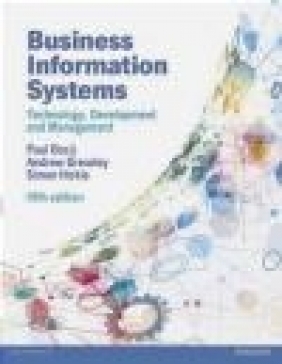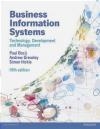Business Information Systems
Simon Hickie, Andrew Greasley, Paul Bocij
Business Information Systems
Simon Hickie, Andrew Greasley, Paul Bocij
- Producent: Pearson
- Rok produkcji: 2014
- ISBN: 9780273736455
- Ilość stron: 704
- Oprawa: Miękka
Niedostępna
Opis: Business Information Systems - Simon Hickie, Andrew Greasley, Paul Bocij
In order to run a successful business, today's manager needs to combine business skills with an understanding of information systems and the opportunities and benefits that they bring to an organisation. Starting from basic concepts, this book provides a comprehensive and accessible guide to: * understanding the technology of business information systems; * choosing the right information system for an organisation; * developing and managing an efficient business information system; * employing information systems strategically to achieve organisational goals. Taking a problem-solving approach, Business Information Systems looks at information systems theory within the context of the most recent business and technological advances. This thoroughly revised new edition has updated and expanded coverage of contemporary key topics such as: * Web 2.0 * enterprise systems * implementation and design of IS strategy * outsourcing Business Information Systems does not assume any prior knowledge of IS or ICT, and new concepts are simply defined. New business examples, case studies and web links are fully integrated throughout, illustrating the relevance and impact of information systems in today's business environment. In addition there are a wealth of questions and exercises both in the book and online at www.pearsoned.co.uk/bis enabling students to test their understanding of key topics and issues. This book is ideal for students on any courses related to business information systems or management information systems at undergraduate or postgraduate level. About the authors Andrew Greasley lectures in Information Systems, Operations Management and Simulation Modelling at Aston Business School, Aston University. Paul Bocij is a Senior Teaching Fellow at Aston Business School. An experienced educator, he has worked for a wide variety of institutions, including universities, colleges and numerous commercial organisations. His commercial experience includes time spent in the fields of programming, management, training and consultancy. Simon Hickie has worked for 20 years as a senior lecturer in business information systems, having previously worked for 10 years in the management information systems field in a variety of roles including progammer, project manager and trainer. His particular interests lie in the areas of information systems in SMEs, change management and strategic information systems management.Preface Guided tour Plan of the book About the authors Acknowledgements Publisher's acknowledgements Part 1 INTRODUCTION TO BUSINESS INFORMATION SYSTEMS 1 Basic concepts - understanding information Links to other chapters Learning outcomes / Management issues Introduction Data and information Creating information Qualities of information Case study 1.1: Technology sponsors a complementary form of capitalism The business environment Managerial decision making Case study 1.2: Dealing with the data deluge Focus on knowledge management Summary Exercises References / Further reading / Web links 2 Basic concepts - an introduction to business information systems Links to other chapters Learning outcomes / Management issues Introduction Introduction to systems Different types of systems Business information systems Resources that support BIS Categories of business information system E-business systems Enterprise systems BIS and strategic advantage Case study 2.1: PayPal eyes in-store retail customers Mini case study: Capital One develops information leadership Case study 2.2: Corporate IT falling short of potential Summary Exercises References / Further reading / Web links 3 Hardware and software Links to other chapters Learning outcomes / Management issues Introduction Components of a computer system Major categories of computers Types of microcomputers Input devices Case study 3.1: Mainframes are thriving in a cloud world Mini case study: Optical mark recognition Case study 3.2: Hertz reaps virtualisation rewards Case study 3.3: Business life - Rise of the paperless meeting Case study 3.4: Cloud is silver lining for German online bank Fidor Output devices Focus on printers Storage devices Processors Categories of software Document production software Graphics packages Spreadsheets Management applications of productivity software Multimedia software Software for using the Internet Focus on software distribution models Summary Exercises References / Further reading / Web links 4 Databases and business intelligence Links to other chapters Learning outcomes / Management issues Introduction Databases Business intelligence Data warehouses Case study 4.1: Big data put under the spotlight as never before Case study 4.2: Making business intelligence work Business analytics Case study 4.3: After 160 years, the value of maps is starting to be appreciated Mini case study: How to get rid of 'devil customers' Mini case study: Using GIS to identify road traffic accident locations Mini case study: Traders' tools turn tables on dodgy deals Summary Exercises References / Further reading / Web links 5 Networks, telecommunications and the Internet Links to other chapters Learning outcomes / Management issues Introduction Computer networks Network components Network types The Internet Case study 5.1: Death of a matchmaker Focus on how the Internet works - Internet standards Focus on mobile or wireless access devices Case Study 5.2: Americans turning off TV and on to digital devices Focus on EDI Focus on Voice over IP (VOIP) Case study 5.3: Asian apps challenge Western dominance Summary Exercises References / Further reading / Web links 6 Enterprise and functional BIS Links to other chapters Learning outcomes / Management issues Introduction Enterprise systems Case study 6.1: ERP: A convincing case must be made before investment Case study 6.2: Managing the supply chain Mini case study: The supply chains that could bind unsuspecting managers Operations information systems Case study 6.3: Retail applications of TPS by Sainsbury's Management information systems Departmental applications Summary Exercises References / Further reading / Web links Part 2 BUSINESS INFORMATION SYSTEMS DEVELOPMENT 7 An introduction to acquiring and developing BIS Links to other chapters Learning outcomes / Management issues Introduction How and why are information systems acquired? Software acquisition and the systems development lifecycle Bespoke development Case study 7.1: Lloyds Bank Insurance Services applies RAD Case study 7.2: Use of waterfall v. agile methods at Mellon Financial Purchase of an off-the-shelf package User development software Case study 7.3: Lascelles Fine Foods Summary Exercises References / Further reading / Web links 8 Initiating systems development Links to other chapters Learning outcomes / Management issues Introduction Reasons for project initiation The feasibility study Risk management Case study 8.1: Recession reveals the dark side of advanced IT Acquisition choices and methods Focus on techniques for comparing systems Mini case study: Feature checklist for comparing three different groupwave products Case study 8.2: Sedgemoor District Council Summary Exercises References / Further reading / Web links 9 BIS project management Links to other chapters Learning outcomes / Management issues Introduction Case study 9.1: Putting an all-inclusive price tag on successful IT The project management process Mini case study: The key to ... project planning Case study 9.2: Project management: Lessons can be learned from successful delivery Steps in project management Focus on a project management methodology: PRINCE2 A project management tool: network analysis Summary Exercises References / Further reading / Web links 10 Systems analysis Links to other chapters Learning outcomes / Management issues Introduction Identifying the requirements Focus on requirements determination in a lean or agile environment Documenting the findings Case study 10.1: IFD drawing - a student records system Focus on soft systems methodology Systems analysis - an evaluation Software tools for systems analysis Case study 10.2: ABC case study Summary Exercises References / Further reading / Web links 11 Systems design Links to other chapters Learning outcomes / Management issues Introduction Aims of system design Case study 11.1: Beaverbrooks the Jewellers Constraints on system design The relationship between analysis and design Elements of design System or outline design Case study 11.2: Systems management: driving innovation should be the main objective Detailed design (module design) Focus on relational database design and normalisation Design of input and output User interface design Focus on web site design for B2C e-commerce Input design Output design Designing interfaces between systems Defining the structure of program modules Security design Design tools: CASE (computer-aided software engineering) tools Error handling and exceptions Help and documentation Focus on: object-oriented design (OOD) Summary Exercises References / Further reading / Web links 12 System build, implementation and maintenance: change management Links to other chapters Learning outcomes / Management issues Introduction System build and implementation Mini case study: Jim Goodnight: crunching the numbers Maintenance Change management Case study 12.1: Applying performance goals to business-process management drives growth and innovation Case study 12.2: Play pick-and-mix to innovate with SOA Summary Exercises References / Further reading / Web links Part 3 BUSINESS INFORMATION SYSTEMS MANAGEMENT 13 Information systems strategy Links to other chapters Learning outcomes / Management issues Introduction The strategic context Introduction to BIS strategy Case Study 13.1: Which cloud model will prevail? Tools for strategic analysis and definition IS and business strategy integration Focus on IS/IT and SMEs Case Study 13.2: Next generation of clients forces pace of IT change Summary Exercises References / Further reading / Web links 14 Information systems management Links to other chapters Learning outcomes / Management issues Introduction Information systems investment appraisal Determining investment levels for information systems in an organisation Locating the information systems management function Outsourcing Mini case study: Customers admit blame for outsourcing failures Case study 14.1: Outsourcing: beware false economies Beyond strategic information systems - the importance of IS capability Focus on IT infrastructure flexibility Pulling it all together: IT governance and COBIT Case study 14.2: IT trends shape future corporate strategies Summary Exercises References / Further reading / Web links 15 Managing information security Links to other chapters Learning outcomes / Management issues Introduction The need for controls Mini case study: Complacent staff weak link in combating cyber criminals Case study 15.1: Online cybercrime rings forced to home in on smaller prey Control strategies Types of controls Some techniques for controlling information systems Focus on malware Case study 15.2: Cybercrime costs US $100bn a year Threats related to Internet services Summary Exercises References / Further reading / Web links 16 End-user computing - providing end-user services Links to other chapters Learning outcomes / Management issues Introduction End-user IS services Managing network services Mini case study: Cyberslacking: employees surf non-work-related web sites End-user computing The IT help desk Mini case study: A snapshot of the role of the IT help desk in the modern organisation Case study 16.1: The 21st-century help desk End-user development Managing EUC as part of IS strategy Case study 16.2: Time to call the help desk? Summary Exercises References / Further reading / Web links 17 Ethical, legal and moral constraints on information systems Links to other chapters Learning outcomes / Management issues Introduction Professionalism, ethics and morality Codes of conduct Social issues Case study 17.1: Small mistakes attract the biggest trouble Legal issues Case study 17.2: Sony fined after lapses at games network Focus on software piracy Mini case study: Pirate Bay hacker jailed for two years Summary Exercises References / Further reading / Web links Glossary Index
Producent:
GPSR Pearson Central Europe Sp. z o.o.
ul. Szamocka 8
01-748 Warszawa (PL)
tel: 459 596 060
email: [email protected]
Szczegóły: Business Information Systems - Simon Hickie, Andrew Greasley, Paul Bocij
Tytuł: Business Information Systems
Autor: Simon Hickie, Andrew Greasley, Paul Bocij
Producent: Pearson
ISBN: 9780273736455
Rok produkcji: 2014
Ilość stron: 704
Oprawa: Miękka
Waga: 1.3 kg






























